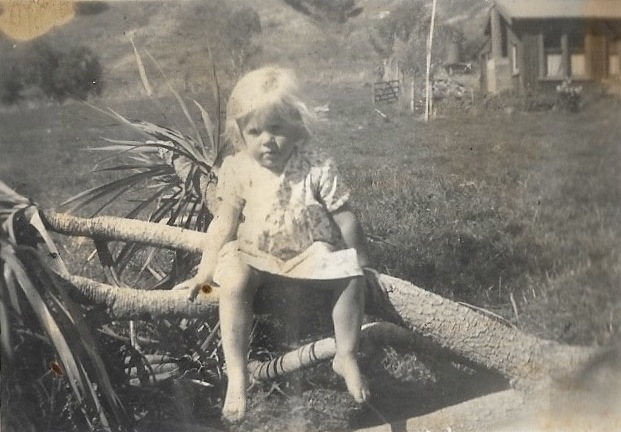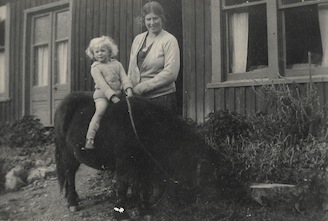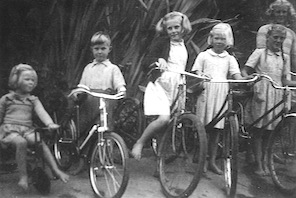When I was born in 1939, my parants ran the farm Puke Puke in the inland valley near Oaro. The farm was on the north side of the river. Sometime after their marriage, my fathers father, Edwin Stanford, came to live with the family. He was called Granda.
When I was very young, Granda still had a farm at Manuka Bay which is on the coast near Cheviot. Because Mum was so busy with twins I used to go and stay with Granda for quite lengthy periods. There was a long windy road in to the house. On the clay banks above the road were lots of holes where the starlings nested. Granda used to help me get the eggs.
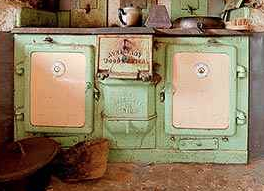
|
Although Granda lived with us after he sold Manuka Bay, he had the cottage, called Pinecroft. He would take us down there and look after us to give Mum a spell. We would have morning tea using tiny little dolls plates and cups and saucers. His speciality was pink wafer biscuits with a liberal spread of mixed butter and sugar in the middle.
Farm Life and Food
Most of the food we ate came from the farm. We had a VERY large vegetable garden. Dad was enormously proud of his broad beans which grew much taller than him. We had at least 2 or may be 3 asparagus beds.
Chicken and eggs Our hen house was away down our large garden on the boundary with the Cow Paddock. About mid day the hens were let out to roam the paddock and scratch around to look for worms and grass. At night they were fed in the hen house. It was usually my job to go down and feed them before we milked. Then also the eggs were collected and the latch was supposed to be let down. If the latch was not let down a ferret or stoat would get in. There would be an awfull noise in the middle of the night which we could hear from the nursery. Dad would get the gun and a torch and hurry down to shoot the ferret. The passion fruit vines came right down to the hen house which made it a dark and spooky place for a young girl. I used to be really frightened of the ferret even though it was dead and even today I do not like them one little bit.
Every year we got day old chickens from Addington Prison.
They came in a box on the bus and were put under one of our broody hens.
When they were bigger Mum put coloured rings on their feet
so she would know how old they were.
The older ones were killed in the autumn and put in the pressure cooker
to get rid of the toughness. Then they were roasted in the oven.
One day the cooking of the hens became a night mare. We were shearing
and Mum needed to come down to the wool shed to help with pressing
wool etc. We had electricity by now and Mum decided to cook two hens
together. But it became apparent that the cooker was too full.
We came back to find that the pressure valve had got blocked and it
had blown to the ceiling making a hole in the pinex. The surrounding
walls were completely covered in slivers of chicken which took a whole
afternoon to clean off. Needless to say I have never used a pressure
cooker since then.
When the hens were laying well and we had too many eggs Mum would preserve them for winter eating. They were put in a very large kerosine tin and covered in Norton's Egg Preserver. The Norton's Egg Preserver was bought from Dalgety's in a tin which had to be opened. Mum must have tried and tried to open it. Somehow she pierced the tin and the neat liquid squirted into both her eyes. She rushed to the house and bathed her eyes in Boracic Acid. She always said that the doctor was sure it had saved her sight.
Milk and milking
In the early days as well as later on when we had power, we milked
about 4 or 5 cows in the cow shed which was part of the sheep
yards. We milked the cows in bare feet so had to tuck our feet under
the stool so they did not get trodden on. In the winter time it was
very cold and we really liked it when the cow let go and our feet were
warmed by the issuing torrent.
The separator shed was right next door. You tipped the milk in to the
bowl and then you had to turn the handle and get it going fast enough
until there was a noise like a Ding. You turned on the tap and the
milk flowed through. The skim milk went in to one bucket and the cream
in to another. We always had bucket fed calves, which we as children
loved to feed on some of the milk. We had plenty of cream and milk for
the house. In the early days we also kept pigs in the orchard and
these were given milk in a trough. Some of the skim milk was left to
go sour and thicken and it was fed to the hens. At night we did not
use the separator but left the milk in buckets and skimmed off the
cream in the morning.
If one of the milking cows had a bull calf, Dad would take it down to the railway station. In those days if you put a calf in you were allowed to take another heifer calf out. Dad tried to choose a Friesian as they always mated well with an Angus bull. We had quite a few milking cows which were Friesian Angus cross. They were very good milkers. Every morning we had oat meal porridge for breakfast which Granda made. It was covered with milk and very thick cream.
Butter We used to make our own butter. The cream had to be sour before you could make butter. We had a butter churn which the cream was put in. You kept turning the handle until the butter separated from the whey. Now it was taken out of the churn and washed in cold water. You had to keep washing until the water was clear. Then you added some salt and using the wooden butter pats you formed it into shapes. We did not have a fridge so the butter was pretty soft and you had to be careful it did not go rancid.
Cooking and baking Mum was a very good cook and much of the baking was to do with cream. She made many, many sponge cakes always filled with cream and home made jam. She also made meringues which were filled with sweetened cream. Once we had electricity she made home made ice cream, and very often for pudding we had a huge bowl of banana passion fruit and cream. What a LOVELY memory!!! (We had 5 different types of passion fruit. One type crossed with another and it was named after Dad. I think it was called Stanfordi Passion flora.)
Meat About every 10 days Dad killed a 2 tooth wether.
We ate mostly mutton. Dad thought a two tooth was better than a lamb.
It was bigger and still nice and tender. Our first meal in the evening
was liver, heart and kidneys. The mutton was hung in a fly-proof meat
safe under the walnut trees with little holes in the wire to let the
air in.
We usually made each leg last 3 meals. First was a big roast,
the next day cold meat and on the 3rd day Mum made a curry with
onions, apples and sultanas. I still make this curry.
When we came to tail the lambs the tails were cut off in those days.
Dad would throw them in to piles of 10 so that he would know how many
lambs were in that mob. We would make a fire out of manuka and when
there were only embers we would throw on the tails. After a while
they were cooked so you could take them off and pull off the skin.
We thought they were lovely. We also made a large billy of tea on the fire.
As an occasional treat we bought Harnett's sausages when we went to Kaikōura which were really delicious.
Food from the sea Each year after a storm we went to the beach and got load after load of sea weed which went on the asparagus beds. We also brought up MANY barrows of sheep manure from the wool shed. In season we had asparagus and scrambled eggs on home made bread, on most nights for tea. We ate a lot of fish and other sea food. Lots and lots of paua and also plenty of cray fish from Dick Baxter. We gave him meat etc, from the farm. Mum thought sea weed was very good for us (Rudolph Steiner philosophy) and she encouraged us to eat it. On one day I ate far too much sea weed that had a lot of sea water in it and so had to vomit it all up. We also ate white bait and little eels which we got from the Oaro Creek and made in to patties.
You would think with all the cream and fatty food I would be heavy. I grew tall very quickly and was quite thin. My mother said she would give me a shilling for every pound I could put on. I never got even one shilling!!
The world around us
The Okairia was a really lovely area, so with the sun setting and the creek below and then the ride home on the back of the truck with all the dogs, us singing all the way, it was like paradise. In those days dogs were not dosed for hydatids so we had to be careful.
By now the ponies were in from the Paparoa Paddock. We did not use saddles, just a bridle and cantered as fast as we could to school. Dad had built us a Pony Paddock near the school so they were left there until lunch time. We used to ride the ponies flat out the mile home for dinner trying to beat the Newman's bus, jumping across all the ditches and waving at the passengers. We always had our main meal in the middle of the day and then tea at night. After dinner we rode our bikes back to school.
I think we got our first generator when I was 8 or 9 (1947). The area between Oaro and Kaikōura was steep bush covered country with many bluffs where the narrow shingle road had been put in. This part of the country was the last in N.Z. to get onto the national grid.
|
|
I was about 10, Prue about 8 and the twins had just learnt to ride a bike and would have been maybe 5 or 6. State Highway 1 was still shingle and around the coast quite narrow. The Punch Bowl was almost one lane with a big drop to the sea below. The Bishop from Nelson was preaching and we always went to church on Sunday (as Granda always said: "otherwise you grow into little heathens") so we could not understand that our father thought we were too busy to go. We were determined to go and asked if we could bike the 16 miles. I seem to remember that one of the twins was riding "Skinny", a bike which had solid rubber tyres. We all learnt to ride on Skinny. I imagine that Dad expected us to get as far as Goose Bay which is not even half way there. We kept on going and when we got to the more dangerous parts where we could have been run over I rode ahead and rang the bell on my bike until I got a blister on my thumb. We must have pushed our bikes up the steep long hill near the Race Course. At last we were at the top! We all sailed off down the hill with the Anglican church at the bottom. The twins were not yet very proficient at using their brakes. I think it was Helen who ploughed across the Main Road, jumped the gutter, went right through the hedge and landed at the feet of the congregation as they came out of church. Thank goodness there was no traffic on the road or there could have been a disaster. My parents arrived soon after with the trailer and Dad was especially delighted and very proud of our effort. How long did it take? I have no idea but may be one and a half hours or a bit more.
My father was a Lay Reader in the church. During the war he used to ride a bike to Kaikōura to take the service and because there were no tyers he used rope instead of rubber.
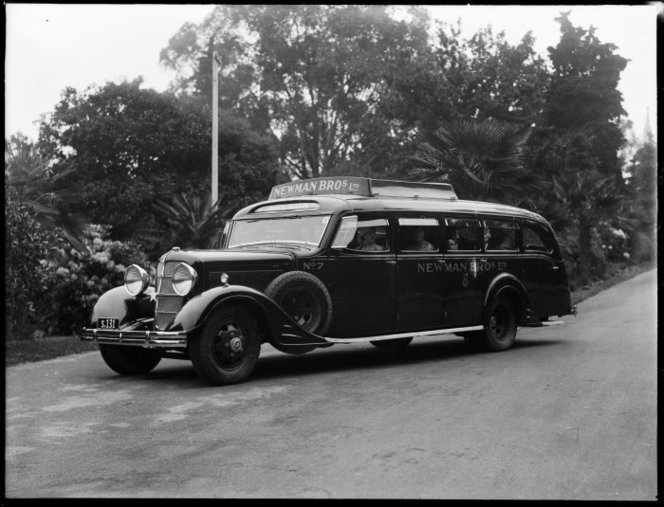 |
In the period between 1945 and 1955 the State Highway 1 was improved.
Until then it was a quite narrow, 2 lane, windy shingle road.
There were often slips and cars breaking down. On one day a slip
came down very near our other cottage Pinecroft, completely blocking
the road, and
the Newman bus stranded.
The Newman's bus passengers were on their way to Nelson.
They all had breakfast.
We used the drawing room and they sat around the large Maori Carved table
(made by dad's grandpa Menzies) being served large plates of porridge
covered in thick cream followed by scrambled egg on home made bread.
Our mother was always very out going and enjoyed a good laugh.
She was delighted that the bus driver was so nice!!
Granda was in the cottage at the time of the slip doing
some bee work. If there had not been a row of huge macrocarpa trees
the cottage and Granda would have been covered or swept away. Gone for
ever was the hay paddock where as a little girl I kept Old Bob, the
draft horse moving with a small stick, as he pulled the machine to cut
the hay.

|
When wool was bringing in such big money during the Korean War (1950-1953), about 1 pound of money for 1 pound of wool, we were all on the look out for dead sheep which we could pluck and sell to Hoppy, who came round in a truck to buy the skins and odd bits of wool. I had found a long dead sheep in the Big Oaro while I was mustering so when I got home I asked Granda if he would come with me to get the wool. Although we loved getting the money it was quite unnerving trying to cope with the smell and all the maggots. Well, we set off, but it was much further than I thought, but Granda struggled on with his "gammy" (his name for his bad limp) up the steep hill until we got there. When we were mustering he always called me "his eyes" as he couldn't see the sheep which were too far away.
Schooling
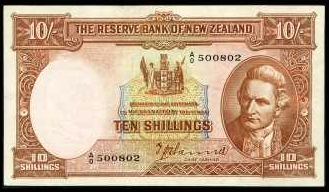
|
When I went to boarding school in Nelson Granda wrote to me regularly and always included a 10 BOB note, a lot of money in those days. I found it very difficult to read his letters. The writing was not the easiest to decipher. At the end of term he would often drive up in the old V8 to collect me and I was allowed to drive on the way home. The roads were still shingle so I only drove on the safer flat areas.
On the night Granda died (in 1956) at about 11 o'clock, I heard the generator start. Granda had managed to bang on Mum's wall with his stick to alert her. I rushed in to see him from the nursery but he was already unable to talk to me so I was unable to say good bye. The younger members of the family did not know he had died until next morning and by then the undertaker had been. In those days children did not go to funerals, and without very many explanations, it gave us, I think, no closure. His passing left a tremendous gap in our lives. Luckily he was there for the whole family while all the children were so young. He was such a great help to not only for our family but the neighbours as well.
In 1960, during the Christmas break, I went hiking with 4 friends. We had taken up the plan to walk the "Heaphy Track" from Karamea on the West Coast (north of Westport) to Bainham-Collingwood (at Golden Bay west of Nelson). A strech of some 80 miles (130 kilometers). We had a map but the track was hardly marked. We had to cross rivers, swamps, ridges and forested parts, we slept on the ground, sometimes in the rain. But we kept going and finally reached Collinwood after 5 days of clambering. There we found lodging, but due to the drought there was no running water so no showering and cleaning. Next morning, at breakfast, people at other tables were snickering at how we "bush girls" looked like. Later, the story appeared in newspapers, among them The Press.
Professional life
After the school in Nelson I went to the teachers
"Training College" in Christchurch.
The education took 3 years.
After that I taught at several elementary schools,
for a period of 3 years each.
They were in Kaikōura, in Gisborne (north island),
then in London (England),
and after having returned to New Zealand
(I met my future husband Henk in Oaro then),
in Lincoln and at Summerfield school in Christchurch.
I married Henkie in 1973.
In all the following years,
whenever it was possible or the opportunity arose,
I did relieving in elementary schools,
in Diamond Harbour and at Somerfield in Christchurch.
Back to the genealogy of AS.
